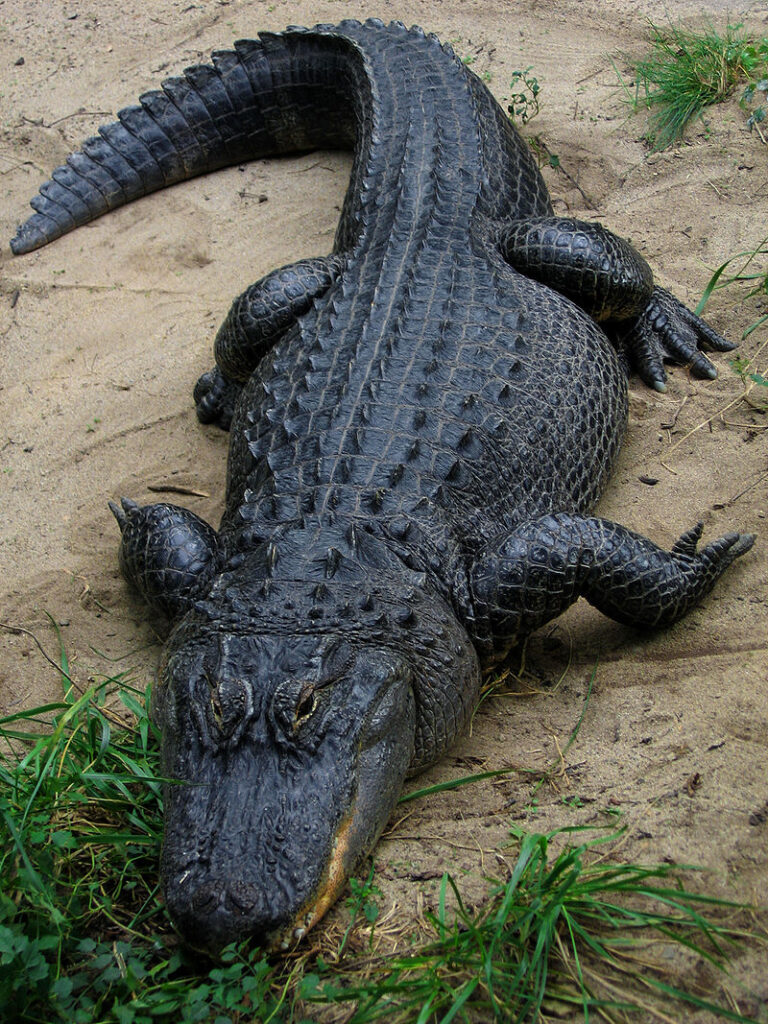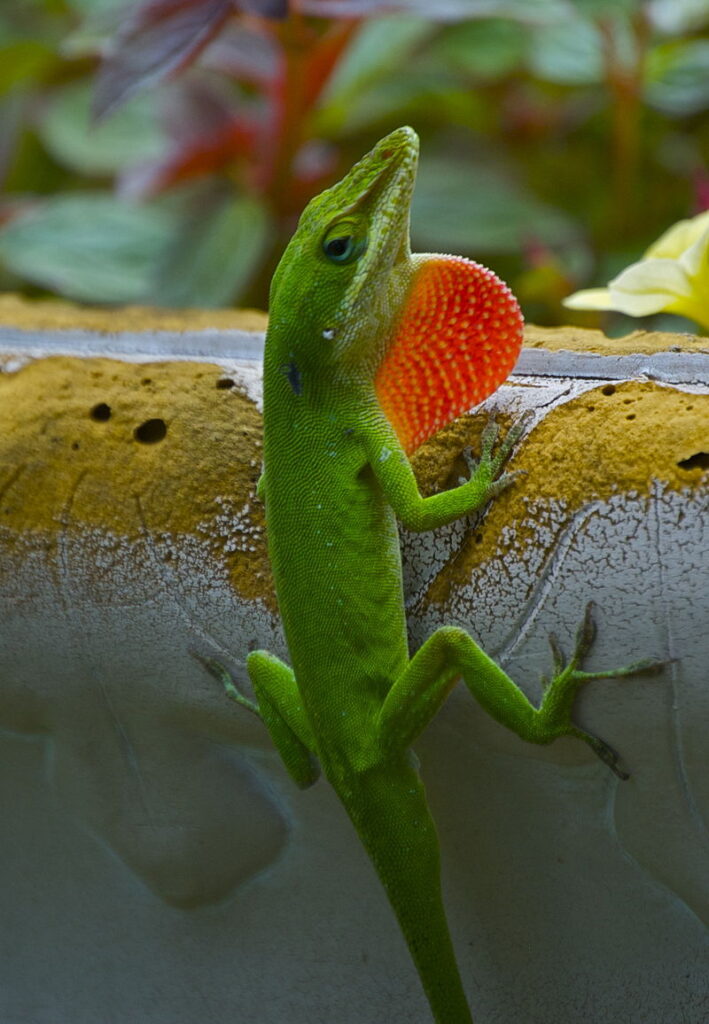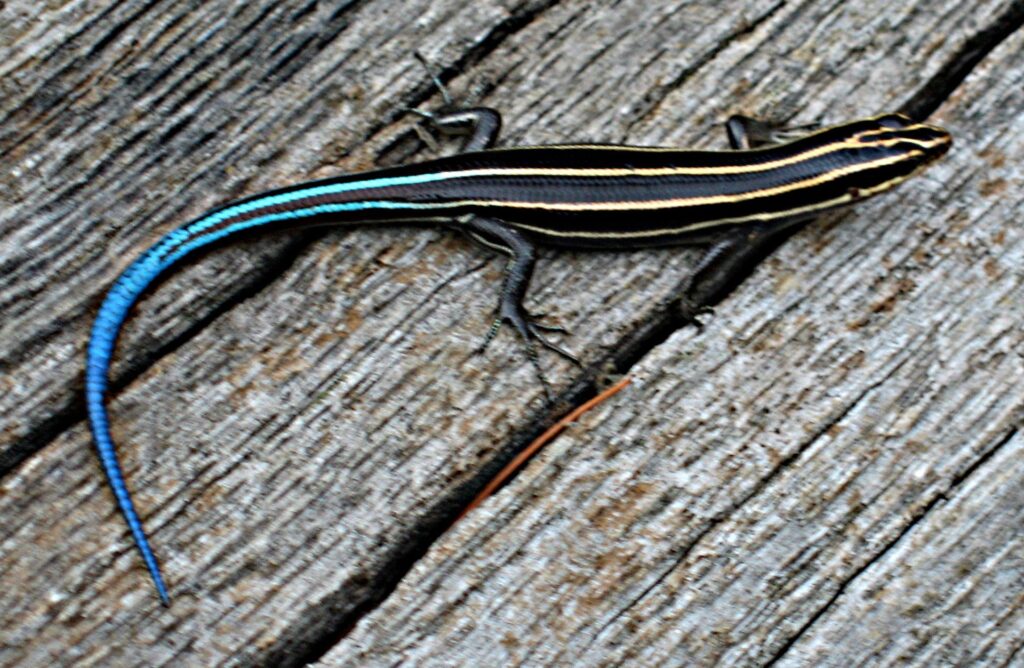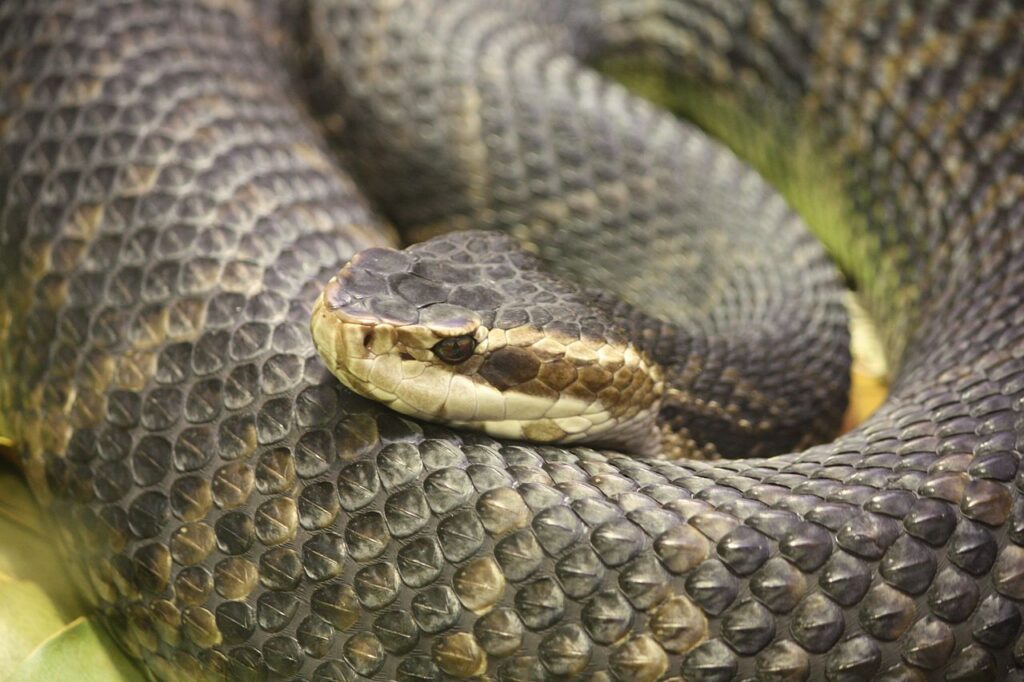On this page you will find information on the:
Alligator, Anole, Blue-Tailed Skink, Snakes.
Alligator:

The American Alligator (Alligator mississippiensis) may be “King of the Bayou” but you sometimes can’t tell because most of the time they look just like a floating log.
Funny thing about how differently people react to the presence of ‘gators. Some live in mortal fear of them and some want to feed them. Millions of alligators inhabit the swamps and marshes of the Gulf Coast states, particularly Louisiana and Florida, where the scaly beast is a colorful part of the local lore. Although the Bayou State contains twice as many wild gators as the Sunshine State, Florida can claim an ugly statistic Louisiana cannot – until recently there had been twenty-one human deaths by alligator recorded there and none here. Part of the problem is that Florida simply has many more humans, a disproportionate number living where ‘gators live. It could also be Louisiana’s coastal people are more rural, familiar with and respectful of the reptile. The situation in Florida seems like a good argument against building subdivisions in wildlife habitat. Unfortunately, all this has helped give the beast a fearsome, and undeserved, national reputation.
A wild alligator that is not fed by humans will remain wild and WANTS to leave people alone. They have plenty to eat in nature, especially with all the fish in the bayou. They are naturally scared of people and would rather swim away and hide than confront a big and possibly dangerous human. But alligators that are fed by humans think “food” when they see one, especially the small ones. They have no scruples.
Anole:

The proper name for Louisiana’s common small lizard is Anole (Anolis carolinensis). They’re sometimes called “chameleons” because, like the African lizard with the curly tail, swivel-socket eyes and smooth moves, they can change color (though the African have a much larger color pallet and can even go polka-dot if they have to).
Depending on the brightness and color of its surroundings, Anole colors are varieties of green or brown. This is courtesy of special cells in their skin called “chromatophores.” On a bad day, like if a cat or a kid mauls it, they turn dark brown, get black circles around their eyes and act morose. Wouldn’t you? Some Anoles come with a rare mutation that makes them blue or yellow but these unfortunates are a lot easier for predators to spot.
The males display for a mate by abruptly stopping when hunting, doing some tiny push-ups, raising their head and extending a bright, ruby-red dewlap from their throat for all to see. He is notifying any nearby females he is a stud and available. To any male lizards he is indicating: “This is MY territory, any girl lizards are mine. GO AWAY.”
Blue-tailed Skink:

If you walk quietly along the wood’s edge you might be lucky enough to spot a Blue-tailed Skink basking in the sun. The observer might think they just saw an exquisite Tiffany jewel piece – an elegant bronze suit with yellow pinstripes and a vivid, eye-catching iridescent blue tail. Older males might even sport a noble red head. Then the lizard will disappear in the blink of an eye and might leave one wondering, “Did I just see what it was I thought I just saw?”
Blue-tailed skinks happen to be the most numerous lizard in North America; from Canada to the Gulf of Mexico and from the Atlantic to the edge of the Great Plains. Their official name is the American Five-lined Skink; scientific Latin name Eumeces fasciatus. They can grow up to eight inches long, live six-years and like moist environments, like swamps.
Predators like snakes, crows, hawks, shrews, moles, opossums, skunks, raccoons and domestic cats may have a go at them, but skinks have a unique defensive strategy: they simply detach their beautiful tails and leave them twitching on the ground as a distraction whist making a getaway. If they survive this encounter they get to grow a replacement tail.
Snakes:

The Louisiana swamps and marshes along the Manchac Greenway are literally crawling with snakes. Go figure.
Snakes are really quite remarkable if you think about it, getting by as they do with only sensory organs and a mouth. They have to be crafty and selective about what they sneak up on and eat so they can get their lips to wrap around it. Fortunately, the world understands their handicap and accommodates them with a cornucopia of tasty things of just the right size. And as a legless creature they get around pretty good, using only the undulations of their bellies.
You’d think such a ridiculously outfitted creature would be considered a boob by the rest of the animal world but since some snakes use venom to secure or punish their victims, this instead, strikes fear in almost all of the other animals, including mighty Man. This characteristic is of Biblical proportions and is transferred to all snakes and, whether they deserve it or not, can be both a blessing and a curse.
Like most of us, snakes just want to be left alone but the suspicion they may be packing venom may guarantee some people get the wrong idea and unjustly whack a perfectly innocent (and useful) snake. In general, snakes usually know you’re there before you know they’re there and will quietly disappear because they want nothing to do with you; nothing personal, but humans are just too big to eat. Merely making a lot of human noise and vibration as you blunder about the woods and avoid reaching under logs before first looking is the best way to avoid an encounter with one of them.
